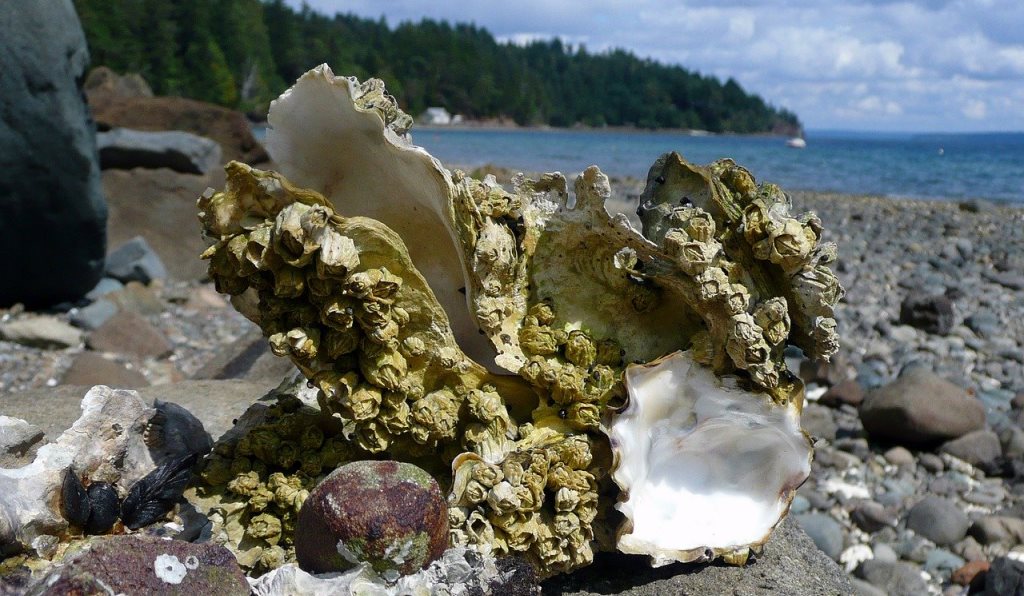For the past three years, the North Carolina Coastal Federation (federation) and the North Carolina Division of Marine Fisheries worked to build a 40-acre oyster reef in Pamlico Sound, which used to be covered in them. The project aims to bring back oysters in the sound and create sparkling clean water.
Now, progress towards restoring that water quality is advancing with the federation’s ambitious goal of restoring 50 million oysters in North Carolina waters by 2020. And the latest progress is the completion of the Swan Island Oyster Sanctuary.
 Each spring and early summer since 2017, the Division of Marine Fisheries and contractors from Stevens Towing Co. Inc., worked to strategically place thousands of tons of limestone marl and granite in the sound to build new oyster habitat. This material serves as a base for baby oysters—known as spat—to land on, colonize and grow up.
Each spring and early summer since 2017, the Division of Marine Fisheries and contractors from Stevens Towing Co. Inc., worked to strategically place thousands of tons of limestone marl and granite in the sound to build new oyster habitat. This material serves as a base for baby oysters—known as spat—to land on, colonize and grow up.
The Swan Island Oyster Sanctuary is one of 15 oyster sanctuaries in Pamlico Sound. This network of sanctuaries, the Senator Jean Preston Oyster Sanctuary Network, is designed to grow new oysters. While reefs in this network are not open to harvest, they are open to hook and line fishing.
As the oysters reach maturity, they repopulate, sending their baby oysters to nearby harvested reefs and to seed the state’s cultch planting reefs. It’s all part of a plan to regrow our state’s oyster population and the sanctuaries are doing a good job.
“We recently completed a comprehensive survey of reefs in Pamlico Sound, including reefs that are harvested, natural, intertidal and subtidal. And what we found, is that while subtidal sanctuary oyster reefs in Pamlico Sound only occupy about 6% of the total footprint of oysters, they account for an estimated 40% of the oyster population in Pamlico Sound,” reported Dr. Dave Eggleston, director of North Carolina State University’s Center for Marine Science and Technology. “Furthermore, these sanctuaries are hosting oysters at densities nearly ten times higher than the other reef types that we monitored.”
“We’re encouraged by the success of the sanctuaries,” said Erin Fleckenstein, coastal scientist in the federation’s Wanchese office and project manager for the restoration project. “They provide insurance for our oyster population in Pamlico Sound. They host adult oysters that help to repopulate our harvested reefs while also filtering the sound and providing habitat for other fish.”
As a complement to the sanctuary construction, the Division of Marine Fisheries has built nearly 145 acres of cultch planted reefs statewide. Some of these are in close proximity to the sanctuary where they can receive spat. These cultch reefs will be open to harvest when oysters reach the legal size of 3 inches.
The effort to restore our oyster populations is especially important after the critical blow that oysters got last fall. With two major hurricanes, Florence and Michael, the oyster population was hit hard. Impacts associated with stormwater runoff, low oxygen water and sediments, decimated oyster populations across the state. It was an impact that was felt by many harvesters during oyster season.

Side scan sonar image of the sound bottom where the reef was built. Differences in color indicate differences in relief of the reef.
This restoration project is part of the 50 Million Oyster Initiative. The initiative aims to build 50 acres of oyster reef by 2020. Each acre supports approximately one million oysters and those 50 million oysters will filter 2.5 billion gallons of water per day.
With the conclusion of the Swan Island Sanctuary, the Division of Marine Fisheries will be working with the federation and partners to identify locations for future restoration efforts.
Funding for all three years of the Swan Island Oyster Sanctuary includes more than $3 million in state appropriations and nearly $3.3 million in grant funds from National Oceanic and Atmospheric Administration’s (NOAA) community-based restoration program. Additional funding was provided by Grady White Boats and federation members.
Featured image of old oyster shell on beach is by ArtTower from Pixabay. All other images courtesy of North Carolina Coastal Federation.

